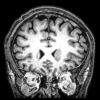The long-term effect is NMDA upregulation, which also upregulates excitotoxicity. Short-term effects are more difficult to characterize, or less studied with less information in the literature.
Alcohol and Cognition in the Elderly: A Review
The brain is highly vulnerable to the neurotoxic effects of alcohol, and cognitive disorders may result from brain damage caused by chronic alcohol abuse.26 The neurotoxic effects of alcohol that cause cognitive deficits may be mediated directly through damage to brain structures or indirectly through malnutrition, metabolite toxicity, electrolyte imbalance, or accompanying physical illnesses including liver disease and infection.27 The direct neurotoxic effect of alcohol is mediated via its action on the NMDA receptors of glutamatergic neurons. Acute alcohol intake exerts an inhibitory effect on NMDA receptors and, thus, induces receptor up-regulation, but when alcohol intake ceases, the up-regulated receptors are no longer inhibited, resulting in an excessive stimulation of NMDA receptors. This, in turn, causes an excessive influx of calcium with cytotoxic effects.26 Glutamatergic neurons are densely concentrated in the frontal lobes and subcortical areas such as the hippocampus, and these brain regions are particularly vulnerable to excitotoxic effects produced by alcohol intake.26 Thiamine deficiency and Korsakoff syndrome resulting from chronic alcohol abuse is an example of indirect alcohol neurotoxicity. Thiamine deficiency causes an excessive release of glutamate which, like alcohol, can exert a neurotoxic effect; in fact, chronic alcohol abuse and thiamine deficiency may have an additive or even synergistic neurotoxic effect.28 Studies of amnesia in patients with Korsakoff syndrome have shown that the condition may have an anterograde component with inability to learn new information, and a retrograde component in which the recent memory is more impaired than remote memory, and a confabulation component associated with these memory defects.29 The apolipoprotein E (APOE) epsilon 4 allele provides a possible genetic explanation for susceptibility to alcohol-induced neurotoxicity. Research findings suggest that people with the allele have a less effective neural repair mechanism and, thus, are more susceptible to the deleterious effects of alcohol.30,31 Elevated serum levels of homocysteine is related to alcoholism,32 and leads to increase of glutamatergic neurotransmission via overstimulation of NMDA receptors.33 This plays a crucial role in the neurobiology of alcoholism, particularly regarding cognitive impairment,34 brain atrophy,35 and alcohol withdrawal seizures.36 Regarding to alcohol neurotoxicity related to immune system, it is reported that chronic alcohol induces systemic cytokines particularly tumor necrosis factor alpha (TNF α). TNF α appears to involve potentiation of glutamate excitotoxicity and activates resident microglia inducing neuroinflammation.37 There are the recent findings in micoglia and astrocyte function toward neurotoxicity via reactive oxygen species under heavy alcohol consumption.37-40 Taken together, alcohol disruption of cytokines and inflammation contribute in multiple ways to a diversity of alcoholic neurotoxicity.
NMDA receptor-mediated excitotoxicity depends on the coactivation of synaptic and extrasynaptic receptors.
N-methyl-D-aspartate receptors (NMDAR) overactivation is linked to neurodegeneration. The current prevailing theory suggests that synaptic and extrasynaptic NMDAR (syn- and ex-NMDAR) impose counteracting effects on cell fate, and neuronal cell death is mainly mediated by the activation of ex-NMDAR. However, several lines of evidence implicate the limitation of this theory. Here, we demonstrate that activation of NMDAR bi-directionally regulated cell fate through stimulating pro-survival or pro-death signaling. While low-dose NMDA preferentially activated syn-NMDAR and stimulated the extracellular signal-regulated kinase ½-cAMP responsive element-binding protein-brain-derived neurotrophic factor pro-survival signaling, higher doses progressively activated increasing amount of ex-NMDAR along with syn-NMDAR and triggered cell death program. Interestingly, the activation of syn- or ex-NMDAR alone did not cause measurable cell death. Consistently, activation of syn- or ex-NMDAR alone stimulated pro-survival but not pro-death signaling. Next, we found that memantine, which was previously identified as an ex-NMDAR blocker, inhibited intracellular signaling mediated by syn- or ex-NMDAR. Simultaneous blockade of syn- and ex-NMDAR by memantine dose-dependently attenuated NMDAR-mediated death. Moreover, long- but not short-term treatment with high-dose NMDA or oxygen-glucose deprivation triggered cell death and suppressed pro-survival signaling. These data implicate that activation of syn- or ex-NMDAR alone is not neurotoxic. The degree of excitotoxicity depends on the magnitude and duration of syn- and ex-NMDAR coactivation. Finally, genome-wide examination demonstrated that the activation of syn- and ex-NMDAR lead to significant overlapping rather than counteracting transcriptional responses.
-----------
[see the mGluR thread]
Selective mGluR5 antagonists MPEP and SIB-1893 decrease NMDA or glutamate-media ted neuronal toxicity through actions that reflect NMDA receptor antagonism
1. The metabotropic glutamate receptors (mGluRs) are a family of G-protein linked receptors that can be divided into three groups (group I, II and III). A number of studies have implicated group I mGluR activation in acute neuronal injury, but until recently it was not possible to pharmacologically differentiate the roles of the two individual subunits (mGluR1 and mGluR5) in this group. 2. We investigated the role of mGluR5 in acute NMDA and glutamate mediated neurodegeneration in cultured rat cortical cells using the mGluR5 antagonists MPEP and SIB-1893, and found that they provide significant protection at concentrations of 20 or 200 microM. 3. These compounds act as effective mGluR5 antagonists in our cell culture system, as indicated by the ability of SIB-1893 to prevent phosphoinositol hydrolysis induced by the specific mGluR5 agonist, (RS)-2-chloro-5-hydroxyphenylglycine (CHPG). 4. However, they also significantly reduce NMDA evoked current recorded from whole cells voltage clamped at -60 mV, and significantly decrease the duration of opening of NMDA channels recorded in the outside out patch configuration. 5. This suggests that although MPEP and SIB-1893 are effective mGluR5 antagonists, they also act as noncompetitive NMDA receptor antagonists. Therefore, the neuroprotective effects of these compounds are most likely mediated through their NMDA receptor antagonist action, and caution should be exercised when drawing conclusions about the roles of mGluR5 based on their use.
------------------
"Lithium has some mGluR5 antagonist effects and has also been utilized in the Drosophila model and in the KO mouse with effects similar to MPEP (McBride 2005, Yan 2005)"
"Lithium also down-regulates the mGluR5 system, and an open trial of lithium in individuals with FXS [fragile X] demonstrated positive behavioral effects, with some signs of improved cognition as well (Berry-Kravis 2008)"
Short-term effects I suspect are a kind of "afterglow", mediated by the same mechanisms.
Gone fishing on wiki for clues, and I found:
Ethanol inhibits the ability of glutamate to open the cation channel associated with the N-methyl-D-aspartate (NMDA) subtype of glutamate receptors. Stimulated areas include the cortex, hippocampus and nucleus accumbens, which are responsible for thinking and pleasure seeking. Another one of alcohol's agreeable effects is body relaxation, possibly caused by neurons transmitting electrical signals in an alpha waves-pattern; such waves are observed (with the aid of EEGs) when the body is relaxed.[citation needed]
Areas of the brain responsible for planning and motor learning are sharpened. A related effect, caused by even low levels of alcohol, is the tendency for people to become more animated in speech and movement. This is due to increased metabolism in areas of the brain associated with movement, such as the nigrostriatal pathway. This causes reward systems in the brain to become more active, which may induce certain individuals to behave in an uncharacteristically loud and cheerful manner.
So having run out of patience... my bes guess is that in those areas an increase in LTP, ATP turnover, neuromodulation, synaptic transmission, or growth related factors. Any of these mechanisms could in part explain the association between light drinking and improved cognition. Further investigation is warranted.
Moderate alcohol consumption and cognitive risk.
We reviewed 143 papers that described the relationship between moderate drinking of alcohol and some aspect of cognition. Two types of papers were found: (1) those that provided ratios of risk between drinkers and nondrinkers (74 papers in total) and (2) those that, although they did not provide such ratios, allowed cognition in drinkers to be rated as "better," "no different," or "worse" than cognition in nondrinkers (69 papers in total). The history of research on moderate drinking and cognition can be divided into two eras: 1977-1997 and 1998-present. Phase I (1977-1997) was the era of neuropsychological evaluation involving mostly young to middle-aged (18-50 years old) subjects. Although initial studies indicated moderate drinking impaired cognition, many later studies failed to confirm this, instead finding no difference in cognition between drinkers and nondrinkers. Phase II (1998-present) was and is the era of mental status exam evaluation involving mostly older (≥55 years old) subjects. These studies overwhelmingly found that moderate drinking either reduced or had no effect on the risk of dementia or cognitive impairment. When all the ratios of risk from all the studies in phase II providing such ratios are entered into a comprehensive meta-analysis, the average ratio of risk for cognitive risk (dementia or cognitive impairment/decline) associated with moderate "social" (not alcoholic) drinking of alcohol is 0.77, with nondrinkers as the reference group. The benefit of moderate drinking applied to all forms of dementia (dementia unspecified, Alzheimer's disease, and vascular dementia) and to cognitive impairment (low test scores), but no significant benefit against cognitive decline (rate of decline in test scores) was found. Both light and moderate drinking provided a similar benefit, but heavy drinking was associated with nonsignificantly higher cognitive risk for dementia and cognitive impairment. Although the meta-analysis also indicated that wine was better than beer or spirits, this was based on a relatively small number of studies because most studies did not distinguish among these different types of alcohol. Furthermore, a number of the studies that did make the distinction reported no difference among the effects of these different types of alcohol. Therefore, at present this question remains unanswered. Analysis also showed that the presence of the apolipoprotein E epsilon 4 allele eliminated the benefit of moderate drinking. However, this was based on a relatively small number of studies and several other studies have found a beneficial effect of the epsilon e4 allele. Further studies are necessary to settle this question. The benefit of moderate alcohol for cognition was seen in both men and women, although the amount and pattern of drinking is very different between the two sexes. Lastly, the finding of unaffected or significantly reduced cognitive risk in light to moderate drinkers was seen in 14/19 countries for which country-specific ratio data were available, with three of the five remaining countries showing nonsignificant reductions as well. Overall, light to moderate drinking does not appear to impair cognition in younger subjects and actually seems to reduce the risk of dementia and cognitive decline in older subjects.





























































